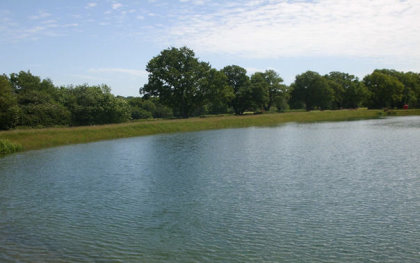
This is the second of a series of practical articles prepared by Bill Hawthorn MIAgrE ASIC GCA, the Irrigation and Water supply specialist Engineer for the Golf Consultants Association and a Director of 2iC Consultants Ltd.
It is designed to help Golf Course Managers and Greenkeepers achieve the very best for the club in regard to its irrigation and water supply needs.
So many clubs are dependant on buying water from the local water company. The cost of water is rising all the time and there is always the fear that when you need the irrigation system most – in a drought – you will be restricted or even cut off.
Just imagine how comforting it would be to have West Sussex Golf Club’s independent water supply (pictured).
It is possible in most cases for your course to become independent of the water company. You are entitled to draw 20m3 (4400 gallons) of water per day from any natural source on your course providing this abstraction rate does not substantially reduce the flow rate of a stream that flows off to other folks land and it does not have a negative effect on the ecology.
The available water sources are:
• Stream or river
• Harvested water from run off (not subject to any restriction)
• Borehole
The major point to remember is that the 20m3/day is available 365 days per year, that is 7300m3 (approx 1.6 million gallons) The key to taking advantage of this resource is storage. The minimum size of this storage should be equivalent to the number of non-irrigating days x 20m3. For example let us assume a dry summer then irrigation days are likely to be 130. So the storage capacity should be: 365 – (130 x20) = 4700m3 (5000).
The most cost effective storage is an open topped earth bank reservoir. Now if the land area is available it would be wise to build something about 8000m3 as this will always leave extra storage that will make it easier to control water quality and gain extra water from harvesting run off.
Such a structure is built without the import or export from the site of any earth thus disruption to the neighbours is minimal. Planning consent is usually reasonably straight forward as the Environment Agency is generally in support of this type of environmentally friendly work.
There are many factors involved with the land contours, soil types, water table etc but a flat area 60m x 80 m could accommodate 8000m3 storage.
Beware of the trap to just add extra water tanks. All that will do is cost a great deal of money and delay running out of water by a couple of days.
So start with a review of water needs then the available resources. A simple geological investigation and maybe a dowsing survey will reveal the borehole potential. Run off areas for water harvesting, roofs, car parks and steeply sloping practice grounds can be easily assessed.
There are obviously many factors to consider so the best line of action is to seek independent advise from a consulting engineer specializing in this area of engineering. GCA has a wide range of experts and for this work Bill Hawthorn MIAgrE ASIC GCA Chief Engineer of 2iC Consultants Ltd is the retained person.
Note: PDF copies of this article can be down loaded from the Golf Consultants Association website. www.golfconsultants.co.uk
Bill Hawthorn MIAgrE ASIC GCA can be contacted via bill@2ic.co.uk

